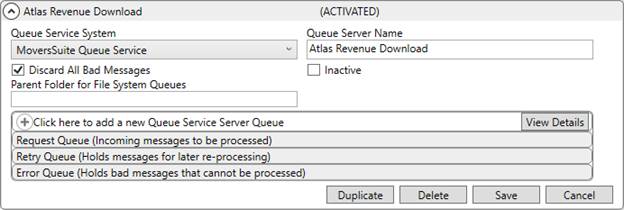
MoversSuite Administration > Queue Service > Queue Service Server Setup
Use this setup to configure queue services for processing message files through the MoversSuite Queue Service. This setup allows you to define a specific queue server referenced by the Queue Service and allows you to define the behavior of requests, retry, error, and mirror queues.

Figure 5: Queue Service Server Setup
The following table lists and describes the fields available through this setup.
|
Field |
Description |
|
Queue Service System |
Select the appropriate service from the list. Currently, only the following option is available:
MoversSuite Queue Service Enable the MoversSuite Queue Service to processes message files from external applications.
|
|
Queue Server Name |
Enter the name of the server connection (up to 64 characters). The server name identifies the queue processes generated from this server. It also appears within the error management tools (Third Party Application Error Management and Third Party Interface Order Monitor). |
|
Discard All Bad Messages |
Check this option to not save message files that the queue service cannot process. Alternatively, if this option is left unchecked, bad message files go into a retry queue. |
|
Inactive |
Check this flag to mark the service inactive. Services marked as inactive are ignored by the queue service. Active services display “(ACTIVATED)” in the title of this setup along with the Queue Server Name. |
|
Parent Folder for File System Queues |
By default, the Queue Service generates a parent folder name automatically based on the Queue Server Name. Alternatively, you can enter a name in this field, if you wish this top-level folder to be of a different name (up to 128 characters). |
|
Queue Service Server Queue |
|
|
Use this section to define up to four roles for each Queue Role. | |
|
Queue Role |
Assign a role to the server by selecting from the following list (up to four roles can be assigned to a server):
Error Queue Specify this role to define a path where message files that cannot be processed are sent.
Mirror Queue Specify this role to create a copy of the incoming message file as is prior to the Queue Service attempt to process it.
Request Queue Specify this role to determine how the incoming messages are to be processed.
Retry Queue Specify this role to hold message files that can be processed but may have data errors for later re-processing.
|
|
Queue Type |
Select the appropriate type for the specified role. The option selected determines which settings are needed. The available types are as follows: File System Folder IBM Messaging Microsoft Messaging
|
|
Settings available for a Queue Type of File System Folder | |
|
Queue Folder Name |
Provide a name for the folder, underneath the parent folder defined as the Queue Server Name (option listed above), to store the message files processed under this queue role (up to 128 characters). For example, if the Queue Role is set to the Retry Queue, then you may set this folder as “Retry.” |
|
Filter |
Enter the file type to include in the list of message files processed by this server queue (up to 32 characters). If processing XML message files, then a Filter of “*.XML” includes all files with an .XML extension. Examples include: *.XML, *.*, SUDS*.TXT, etc. |
|
Minimum Message Age |
Enter the number of milliseconds to hold a file until an attempt to reprocess it is attempted. Note: 1,000 milliseconds is one second. |
|
Message Type |
Select the type of message to be processed under this Queue Role. The following options are available: -none- AtlasSuds Messages EasyDPS Messages XML Messages
|
|
Settings available for a Queue Type of IBM Messaging | |
|
Name of the IBM Messaging Queue |
Enter the name of the IBM message queue that this queue will be listening to for new message files (up to 128 characters). |
|
Queue Manager Name |
Provide the name of the IBM manager process to listen for new messages files (up to 64 characters). |
|
Channel Name |
Provide the name of the IBM channel to listen for new messages files (up to 64 characters). |
|
Connection Name |
Provide the name of the IBM connection to listen for new messages files (up to 64 characters). |
|
Default Receive Format |
Specify the default format to interpret receiving files under. The following options are available: -none- MQHRF2 (TransDocs)
|
|
Use Message Grouping |
Check this option if you wish to turn on group messaging for IBM message files. |
|
Transport Type |
Select the appropriate transport type for this service. The following options are available: -none- TCP/IP
|
|
Encoding |
Select the appropriate conversion type of message files associated to this service. The following options are available: -none- ASCII
|
|
Settings available for a Queue Type of Microsoft Messaging | |
|
Path to the Microsoft Messaging Queue |
Enter the path location to send message files from a Microsoft Messaging queue (up 128 characters). |